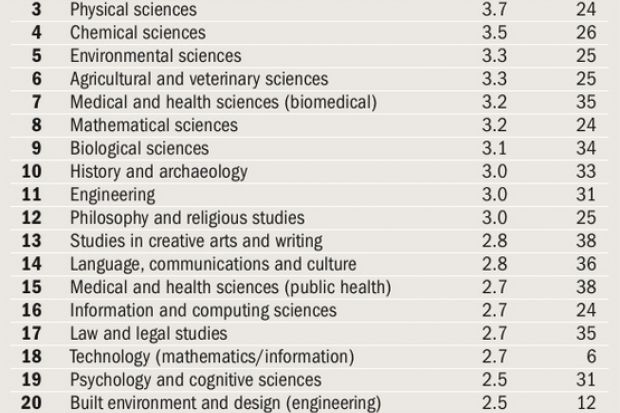Australian research is much stronger in the sciences than the humanities and social sciences, according to the country's first national research assessment programme.
Excellence in Research for Australia (ERA) also indicates that the bulk of the best research is carried out in the elite Group of Eight institutions.
The exercise assesses how Australian research in 25 broad research fields (see table below) and 157 standardised subject categories measures up to international standards.
Kim Carr, minister for innovation, industry, science and research, said the ERA had given taxpayers assurance that their money was being "invested wisely" and given the state "a clear idea of the research areas we need to focus on for improvement and continued excellence". He said the results would inform negotiations with universities over their future budgets.
About 65 per cent of the ERA's "units of evaluation" (UoEs) - disciplines at specific universities - are rated at world standard or above.
But of the 19 subjects highlighted as particularly strong by the Australian Research Council (ARC), which carried out the exercise, only one - historical studies - is a non-science subject.
Most science fields are ranked as above world standard, while the majority of social science fields are judged to be below the benchmark. Humanities fields typically hover around the world standard mark.
'Chronic underfunding'
Christina Parolin, executive director of the Australian Academy of the Humanities, denied that the results showed that the field was underperforming.
"What ERA demonstrates is that where there have been institutional investments in humanities research, there are clear dividends," she said. "Long-term structural biases, disincentives and inequities in the funding system have led to the marginalisation and chronic underfunding of humanities research."
She said the incumbent government had begun to address some of the "inequities", but still had "a long way to go".
Bob Williamson, secretary for science policy at the Australian Academy of Science, agreed that the country was strong in "precisely the fields where there has been substantial and continuous government investment over the past 30 years".
Dr Parolin also flagged up the differing methodologies used to rate the different fields: assessment in the sciences had drawn heavily on quantitative metrics such as citation counts, she said, whereas peer review had been the main method in the humanities and social sciences.
"Peer review generally offers more conservative outcomes than quantitative metrics," she claimed.
The rankings allotted to academic journals have also been a source of controversy and Dr Parolin welcomed the ARC's commitment to revisit them before the ERA's next iteration in 2012.
Peter Rathjen, deputy vice-chancellor for research at the University of Melbourne, said the lower scores in social sciences and the humanities were also partly the result of a highly centralised funding system that did not cover the indirect costs of research.
"The result is that institutions have relatively little capacity to set or invest in distinctive research priorities, such as humanities and social science," he said.
Model results
Melbourne aspired to be the leading "comprehensive" research university in Australia, Professor Rathjen said and he was happy that it had attained high rankings across a wide range of disciplines.
He added that more than 99 per cent of Melbourne's research was classified as world standard or above; the institution also produced the greatest amount of research rated "well above" the global yardstick.
"Taking the volume of our output into consideration, we can reasonably claim to be producing 18 per cent of the most highly rated Australian research," Professor Rathjen said.
But he agreed with the ARC that there was no "sensible way to use ERA outcomes to provide an institutional ranking list - although this would likely favour Melbourne".
Nevertheless, The Australian newspaper has produced a league table based on an average of each university's scores. It placed the Australian National University top and Melbourne second. All the top places were occupied by Group of Eight members.
The analysis also indicates that 29 of the country's 41 higher education institutions offer an average research performance that is below international standards.
Ian Chubb, vice-chancellor of the Australian National University, told the newspaper this indicated that research funding was being spread too thinly. "The results from the ERA will focus hearts and minds on why certain underperforming areas of research should be kept going," he said.
Register to continue
Why register?
- Registration is free and only takes a moment
- Once registered, you can read 3 articles a month
- Sign up for our newsletter
Subscribe
Or subscribe for unlimited access to:
- Unlimited access to news, views, insights & reviews
- Digital editions
- Digital access to THE’s university and college rankings analysis
Already registered or a current subscriber? Login
